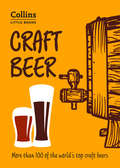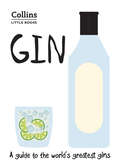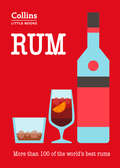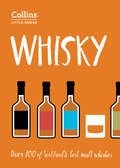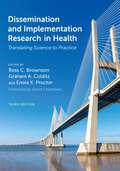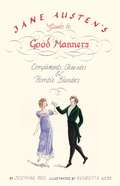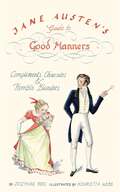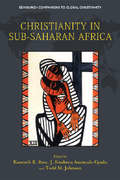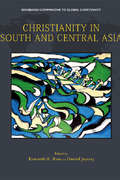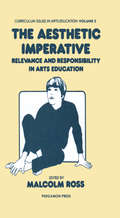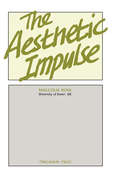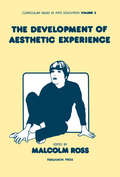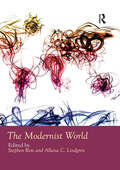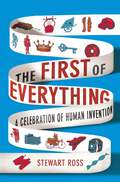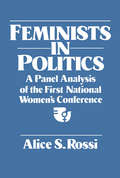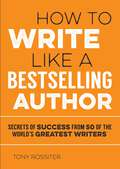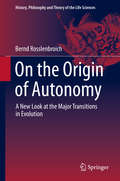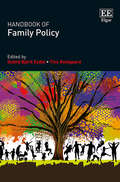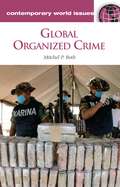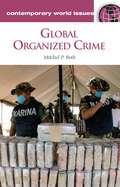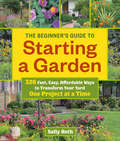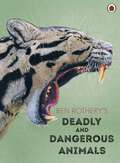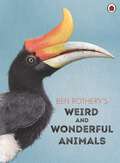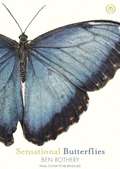- Table View
- List View
Craft Beer: More than 100 of the world’s top craft beers (Collins Little Books)
by Dominic RoskrowThis beautifully presented Little Book is an excellent introduction to the world of craft beer including the major UK, US, and European microbreweries. It includes a fascinating history of the product, how it’s made, how best to drink it and details of the world’s finest craft beers.
Gin: A guide to the world’s greatest gins (Collins Little Books)
by Dominic RoskrowThis beautifully presented Little Book is an excellent introduction to the world of gin. It includes a fascinating history of the product itself, how it’s made, how best to drink it and details of the world’s best gins.
Rum: More than 100 of the world’s best rums (Collins Little Books)
by Dominic RoskrowThis beautifully presented Little Book is an excellent introduction to the world of rum. It includes the very best product from the Caribbean, UK, and US as well as new and emerging markets. With a fascinating history of the product itself, how it’s made, and details of the world’s best rums, this is perfect for all rum lovers.
Whisky: Malt Whiskies Of Scotland (Collins Little Books)
by Dominic RoskrowThis beautifully presented Little Book is an excellent introduction to the world of Scotch whiskies. It includes the major Scotch whiskies and the distilleries that produce them.
Dissemination and Implementation Research in Health: Translating Science to Practice
by Ross C. Brownson, Graham A. Coldi TZ, Enola K. ProctorThe ultimate guide to dissemination and implementation research for public health, medicine, and the social sciences In the past twenty years, dissemination and implementation (D&I) research has sought to narrow the gap between the discovery of new knowledge and its application in public health, mental health, and health care settings. The challenges of moving research to practice and policy are universal, and future progress calls for collaborative partnerships and cross-country research. The fundamental tenet of D&I research-taking what we know about improving health and putting it into practice-must be the highest priority. Dissemination and Implementation Research in Health is the definitive roadmap to effecting change in health and science from today's leading D&I researchers. With insights from around the globe, these scholars collectively address key issues in the field including how to evaluate evidence based on effective interventions, how to design an appropriate study, and how to track a set of essential outcomes. Their work has been updated in this third edition with a strong focus on health equity and new chapters on de-implementation, scale-up and sustainment, and training and capacity building. This new edition also focuses on barriers to uptake of evidence-based interventions in the communities where people live their lives and from the social service agencies, hospitals, and clinics where they receive care. Now in its third edition, Dissemination and Implementation Research in Health remains the quintessential guide to making research more consequential for researchers and practitioners in health and the social sciences.
Jane Austen's Guide to Good Manners: Compliments, Charades and Horrible Blunders
by Josephine Ross Henrietta WebbHow to pay and return formal 'calls'; how to refuse a proposal of marriage; who should lead off the dancing at a country-house ball; what to wear for a morning walk... Today such social niceties are largely ignored or forgotten, but they underpin all of Jane Austen's timeless novels and are explored and dealt with in this highly original book.Written as if intended for Austen's original readers in the Regency era, and illustrated with exquisitely witty watercolours, Jane Austen's Guide to Good Manners is a light-hearted, entertaining and instructive little handbook of etiquette as depicted in Jane's novels and letters. It will not only offer sound wisdom and pearls of advice, but also encourage the modern-day reader to look back at Jane's work with a new and deepened appreciation.
Jane Austen's Guide to Good Manners: Compliments, Charades & Horrible Blunders
by Josephine Ross Henrietta WebbJane Austen's Guide to Good Manners is a light-hearted, insightful handbook written as if intended for her original Regency Era readers, and illustrated throughout with beautiful watercolors. When Anna, Jane Austen's young niece, sent her a novel for ""literary comment," Jane loved everything about it, except its utter disregard for the manners of the day. The resulting and tender correspondence between the two serves as the foundation for this instructional book. Etiquette and social behavior of the early 1800s come to life in lovely chapters teaching one on how to pay and return formal "calls," how to properly refuse a proposal of marriage, who should lead off the dancing at a country-house ball, and what to wear for a morning walk. Jane Austen used these daily customs and niceties to brilliantly illuminate the cloistered world of high society women in her timeless novels. Now with this delightful handbook of correct social behavior, readers will learn just why Mrs. Bennet of Pride and Prejudice couldn't call alone on her new, rich, bachelor neighbor and had to force the reluctant Mr. Bennet to do so...even as he uttered "Tis an etiquette I despise." An indispensable gift for any Austen fan, this beautiful book will prove irresistible to anyone wishing to go back in time to the atmosphere of their favorite Austen novels. Henrietta Webb is the co-creator of Bad Hair. Josephine Ross has written a number of books including, most recently, Jane Austen: A Companion, published in England by Austen's original publisher John Murray.
Christianity in Sub-Saharan Africa (Edinburgh Companions to Global Christianity)
by Kenneth Ross J. Kwabena Asamoah-GyaduThis comprehensive reference volume covers every country in Sub-Saharan Africa, offering reliable demographic information and original interpretative essays by indigenous scholars and practitioners. It maps patterns of growth and decline, assesses major traditions and movements, analyses key themes and examines current trends.
Christianity in Sub-Saharan Africa (Edinburgh Companions to Global Christianity)
by Kenneth Ross J. Kwabena Asamoah-GyaduThis comprehensive reference volume covers every country in Sub-Saharan Africa, offering reliable demographic information and original interpretative essays by indigenous scholars and practitioners. It maps patterns of growth and decline, assesses major traditions and movements, analyses key themes and examines current trends.
Christianity in South and Central Asia (Edinburgh Companions to Global Christianity)
by Kenneth R. Ross Daniel Jeyaraj Todd M. JohnsonThis comprehensive reference volume covers every country in South and Central Asia, offering reliable demographic information and original interpretative essays by indigenous scholars and practitioners. It maps patterns of growth and decline, assesses major traditions and movements, analyses key themes and examines current trends.
The Aesthetic Imperative: Relevance and Responsibility in Arts Education
by Malcolm RossThe Aesthetic Imperative: Relevance and Responsibility in Arts Education is a collection of papers that covers various concerns in assessment in the context of arts education. In the first chapters, the text examines the predicament of the arts. The next two chapters relate assessment in the context of esthetic education and evaluation in the arts. Chapter 4 talks about the assessment of esthetic developments in the visual mode. The fifth chapter details the importance of evaluating the quality of the test itself, while the sixth chapter covers the conflict between schools and art education. In Chapter 7, the book talks about treating English as an art. The eighth chapter discusses the relevance of art in education, while the ninth chapter provides a conclusive discussion on art education. The text will be of great interest to readers who are concerned with the status of art as part of a school curriculum.
The Aesthetic Impulse
by Malcolm RossThe Aesthetic Impulse explains aesthetic as describing a significant area of the school curriculum that would include but not be confined to the creative arts. Organized into 10 chapters, this book begins with a discussion on arts education. Subsequent chapters explain art, sensibility, aesthetics, and the vernacular principle. The concept of arts education as cultural education, which means responding to the young's needs to generate individual and group identity, is also described. Other chapters explore the aesthetic curriculum and assessment of aesthetic development.
The Development of Aesthetic Experience: Curriculum Issues in Arts Education
by Malcolm RossCurriculum Issues in Arts Education, Volume 3: The Development of Aesthetic Experience focuses on the processes, methodologies, and approaches involved in the development of aesthetic experience, including art education, developmental theories, and aesthetic assessment. The book first tackles the concept of aesthetic development and aesthetic dimension in art education. The text then explores the psychological viewpoint of aesthetic development and aesthetic development in music. Topics include music education, music and function, task of teachers, developmental relationships between processes or roles, and uses and misuses of developmental theories.The publication ponders on the role of teachers and students, aesthetic development in dance, and drama as learning, art, and aesthetic experience. The manuscript then examines emotional development in adolescence, meaning in aesthetic experience, and aesthetic assessment and the reliability factor.The book is a reliable source of information for educators and readers interested in the development of aesthetic experience.
The Modernist World (Routledge Worlds)
by Stephen Ross Allana C. LindgrenThe Modernist World is an accessible yet cutting edge volume which redraws the boundaries and connections among interdisciplinary and transnational modernisms. The 61 new essays address literature, visual arts, theatre, dance, architecture, music, film, and intellectual currents. The book also examines modernist histories and practices around the globe, including East and Southeast Asia, South Asia, Sub-Saharan Africa, Australia and Oceania, Europe, Latin America, the Middle East and the Arab World, as well as the United States and Canada. A detailed introduction provides an overview of the scholarly terrain, and highlights different themes and concerns that emerge in the volume. The Modernist World is essential reading for those new to the subject as well as more advanced scholars in the area – offering clear introductions alongside new and refreshing insights.
The First of Everything: A History of Human Invention, Innovation and Discovery
by Stewart RossA lively and highly readable account of the origins, invention and discovery of just about everything on the planet, the truly global coverage of The First of Everything ranges from the Big Bang to driverless cars.The First of Everything follows a context-setting introduction with seven stimulating sections: In the Beginning (The Big Bang to Homo Sapiens), At Home (the first glass windows to dentures and bikinis); Health and Medicine (herbs to heart transplants); Getting About (donkeys to double deckers); Science and Engineering (potter’s wheel to webcam); Peace and War (the first king to fighter-bombers); and Culture (cave painting to rap). This fascinating book takes in the full sweep of human development and ingenuity over twelve millennia; Africa, for example, gave us the first monarch, algebra and great religions emerged from the Middle East, democracy was born in Europe, and America made the first flying machines. More than just a string of dry lists, the colourful text’s intriguing insights and asides make it as enjoyable for the casual browser as the more serious researcher.
Feminists in Politics: A Panel Analysis of the First National Women's Conference
by Alice S. RossiFeminists in Politics: A Panel Analysis of the First National Women's Conference provides a systematic study of the impact of the National Women’s Conference held in Houston, Texas, in November 1977, on the participants. It traces the past political activities of the conference participants; what they actually did during the conference; the impact of the conference on their commitment to political action in the future; and their aspirations for holding elected office in American politics or in organizations associated with the feminist movement. The volume begins by placing the IWY Commission and the study of the conference in the context of feminist history—both the long-term history that reaches back to Seneca Falls in 1848 and the short-term history of more recent post-1965 political developments. Subsequent chapters deal with design, variable measurement, and response pattern analysis; political organization and group formation; the differences between Pro-Plan and Anti-Plan activists at the conference; and the past political development of the delegates and their political aspirations. This impact analysis will be of interest to political scientists and sociologists, as well as to political activists concerned with the efficacy of alternative action strategies.
How to Write Like a Bestselling Author: Secrets of Success from 50 of the World's Greatest Writers
by Tony RossiterIlluminating the best-known works of 50 celebrated authors, writing coach Tony Rossiter shows you how they achieved their phenomenal success. He explains how each author began writing, and examines their style, techniques and routine for creative insights. If you want to write a bestseller, this guide will set you on the path to success.
On the Origin of Autonomy: A New Look at the Major Transitions in Evolution (History, Philosophy and Theory of the Life Sciences #5)
by Bernd RosslenbroichThis volume describes features of autonomy and integrates them into the recent discussion of factors in evolution. In recent years ideas about major transitions in evolution are undergoing a revolutionary change. They include questions about the origin of evolutionary innovation, their genetic and epigenetic background, the role of the phenotype and of changes in ontogenetic pathways. In the present book, it is argued that it is likewise necessary to question the properties of these innovations and what was qualitatively generated during the macroevolutionary transitions.The author states that a recurring central aspect of macroevolutionary innovations is an increase in individual organismal autonomy whereby it is emancipated from the environment with changes in its capacity for flexibility, self-regulation and self-control of behavior.The first chapters define the concept of autonomy and examine its history and its epistemological context. Later chapters demonstrate how changes in autonomy took place during the major evolutionary transitions and investigate the generation of organs and physiological systems. They synthesize material from various disciplines including zoology, comparative physiology, morphology, molecular biology, neurobiology and ethology. It is argued that the concept is also relevant for understanding the relation of the biological evolution of man to his cultural abilities.Finally the relation of autonomy to adaptation, niche construction, phenotypic plasticity and other factors and patterns in evolution is discussed. The text has a clear perspective from the context of systems biology, arguing that the generation of biological autonomy must be interpreted within an integrative systems approach.
Handbook of Family Policy
by Tine Rostgaard Gudný B. EydalAcross the globe, family policy is becoming ever more important in tackling key issues such as poverty, child welfare and the state of the economy in general. The Handbook of Family Policy examines how state and workplace policies support parents and their children in developing, earning and caring. With original contributions from 44 leading scholars, this Handbook provides readers with up-to-date knowledge on family policies and family policy research, taking stock of current literature as well as providing analyses of present-day policies, and where they should head in the future. The Handbook is divided into five main sections: history, concepts, theory and methods of family policy research; family policies; family policy models; outcomes of family policies; and future challenges for family policy making and research. Beneficial for both scholars already familiar with the field as well as newcomers, this Handbook provides important insights into the architecture and mechanisms of different family policy models. Family policy makers would also greatly benefit from the detailed advice on how family policies may adapt and progress in the future.
Global Organized Crime: A Reference Handbook (Contemporary World Issues)
by Mitchel P. RothThis book offers a comprehensive, multidimensional look into the major activities, groups, causes, and policing strategies related to global organized crime.Global Organized Crime: A Reference Handbook examines global organized crime dating back to its 17th-century roots. Unlike most works on the subject, which take a parochial approach by concentrating on individual countries or regions, this book uniquely details the impact of 21st-century globalization on such groups and their activities.Exploring the continuum of international organized crime and related developments from its early beginnings to the present era, the book also looks at the complicated issues that continue to influence its growth. It covers the impact of the end of the Cold War, immigration, the global drug trade, weapons sales, human smuggling and trafficking, the convergence of funding sources, and the effects of technology. What especially distinguishes this book is the connections it makes between organized crime activities and failed states, civil wars, political transitions, regional conflicts, and terrorist groups.
Global Organized Crime: A Reference Handbook (Contemporary World Issues)
by Mitchel P. RothThis book offers a comprehensive, multidimensional look into the major activities, groups, causes, and policing strategies related to global organized crime.Global Organized Crime: A Reference Handbook examines global organized crime dating back to its 17th-century roots. Unlike most works on the subject, which take a parochial approach by concentrating on individual countries or regions, this book uniquely details the impact of 21st-century globalization on such groups and their activities.Exploring the continuum of international organized crime and related developments from its early beginnings to the present era, the book also looks at the complicated issues that continue to influence its growth. It covers the impact of the end of the Cold War, immigration, the global drug trade, weapons sales, human smuggling and trafficking, the convergence of funding sources, and the effects of technology. What especially distinguishes this book is the connections it makes between organized crime activities and failed states, civil wars, political transitions, regional conflicts, and terrorist groups.
The Beginner's Guide to Starting a Garden: 326 Fast, Easy, Affordable Ways to Transform Your Yard One Project at a Time
by Sally RothThe Beginner&’s Guide to Starting a Garden: 326 Fast, Easy, Affordable Ways to Transform Your Yard One Project at a Time simplifies the garden design process by showing you how to tackle one small area at a time.
Ben Rothery's Deadly and Dangerous Animals
by Ben RotheryExplore what it takes to be counted among the deadliest animals on Earth . . .From the saltwater crocodile's strong bite to the golden eagle's speed as it attacks from the air, many of the creatures you'll discover here are built for danger. But what makes a chameleon or ant so threatening, and which creature is deadliest to humans despite its tiny size?Find out with award-winning illustrator Ben Rothery's fact-filled world of the most spectacular and sometimes surprisingly dangerous creatures on our planet.Fun to read together or independently, this beautifully illustrated book is perfect for nature-lovers of all ages.Also available: Hidden Planet, Water World and Sensational Butterflies.
Ben Rothery's Weird and Wonderful Animals
by Ben RotheryDiscover the weirdest and most wonderful creatures of Planet Earth!In this curated collection, award-winning illustrator Ben Rothery pairs fascinating facts with his stunning artwork to bring you the most incredible creatures in the animal kingdom. From the bone-crunching beard vulture to the venomous platypus and to the miscroscopic tardigrade that can survive for up to 30 years without food or waterand many, many more , you'll enjoy exploring just how weird and how wonderful the world of animals can be!
Sensational Butterflies
by Ben RotheryButterflies and moths are some of the most amazing creatures in nature. There are over 180,000 different kinds and they can be found on every continent except the Antarctic. From Monarchs to swallowtails, Blue Morphos to birdwings, the intricate beauty of butterflies spans the globe and yet also settles close to home in a child's garden, local park or window box. This large-format book brings the vibrancy and ecosystem of butterflies to life with simple text and gorgeous illustrations, covering the key butterfly and moth families and including scores of fascinating facts. Learn the unique way that butterflies see, or be amazed by the multiple double-page spreads showing wingspans in sensational detail.A stunning showcase of the world's butterflies and moths, debuting one of the UK's finest natural history illustrators, Ben Rothery.
